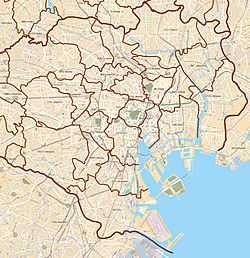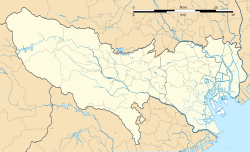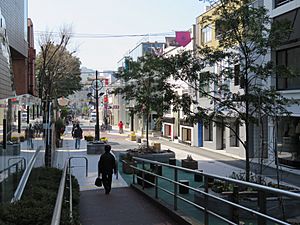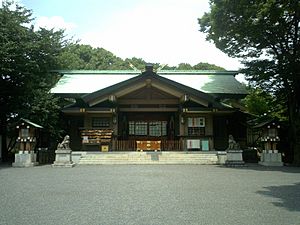Harajuku facts for kids
Quick facts for kids
Harajuku
原宿
|
|
|---|---|
|
Urban area
|
|
| Jingūmae 1 chōme to 4 chōme | |
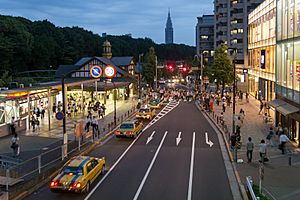
Harajuku Station (left), with Meiji Shrine forest as background
|
|
| Country | |
| City | |
| Ward | Shibuya |
Harajuku (原宿) is a super famous area in Shibuya, Tokyo, Japan. It's known all over the world for its amazing Japanese street fashion and youth culture. When people talk about Harajuku, they usually mean the area around Harajuku Station and Omotesando. But it also includes smaller, fun streets like Takeshita Street and Cat Street.
Harajuku is a top spot for shopping and eating. You'll find lots of small, cool boutiques and cafés that are popular with young people. Big international stores and fancy luxury brands also have shops along Omotesando.
Harajuku Station (on the JR East Yamanote Line) and Meiji-jingumae 'Harajuku' Station (on the Tokyo Metro lines) are easy ways to get here. These stations also lead to famous places like the Meiji Shrine, Yoyogi Park, and Yoyogi National Gymnasium. This makes Harajuku one of Tokyo's most popular places for both Japanese and international visitors.
Contents
Harajuku's Past: A Journey Through Time
Early Days: Before the Edo Period
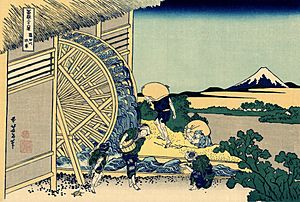
Long, long ago, before the Edo period, Harajuku was just a small town on the Kamakura Highway. People say that a famous warrior, Minamoto no Yoshiie, gathered his soldiers here. There's even a hill called Seizoroi-saka, which means "soldiers lining up hill."
Later, in 1590, some special ninja from Iga were given land here. This was a reward for helping a very important leader, Ieyasu Tokugawa, stay safe.
Edo Period: Protecting the City
During the Edo period, the Iga ninja clan had a residence in Harajuku. This was to help protect Edo (which is now Tokyo) because Harajuku was in a good, strategic spot. There were also many homes of important government officials.
Farmers in the area mostly cleaned rice and milled flour using watermills on the Shibuya River. But the land wasn't very good for farming. So, the villages didn't become very rich. People even say farmers often prayed for rain at local shrines to help their crops.
Modern Times Begin: Meiji Restoration to World War II
When the Meiji period started in 1868, the land around Harajuku Village became part of Tokyo. In 1906, Harajuku Station opened, making it easier to travel here.
In 1919, the famous Meiji Shrine was built. To make a grand entrance, Omotesando street was made wider and more formal. Later, in 1943, the Tōgō Shrine was built to honor a brave naval leader, Tōgō Heihachirō. Sadly, much of the area was destroyed by fires during World War II in 1945.
After the War: New Beginnings
After World War II, American soldiers and their families lived in an area called Washington Heights. This land is now Yoyogi Park and the Yoyogi National Gymnasium. Shops like Kiddyland and Oriental Bazaar opened along Omotesando to serve these families.
In 1964, Tokyo hosted the 1964 Summer Olympics. Swimming and diving events took place at the nearby Yoyogi National Gymnasium. In 1965, the official name of the area changed to Jingumae. But because of the train station, everyone still called it Harajuku!
The Rise of Fashion and Fun: 1970s and 1980s
In the 1970s, young people who loved fashion started coming to Harajuku. A building called Palais France opened, selling trendy clothes and cool items. Then, in 1978, the famous Laforet Harajuku fashion building opened. This made Harajuku widely known as a center for fashion and shopping.
In the 1980s, Takeshita Street became famous for teenage street dancers called takenoko-zoku. On Sundays, local roads were closed to cars, creating a pedestrian zone. This brought huge crowds, sometimes up to 10,000 people! They came to watch Rock 'n' Rollers and other bands perform live in Yoyogi Park. This special Sunday pedestrian zone ended in 1998.
Harajuku Today: Global Trends and Unique Styles
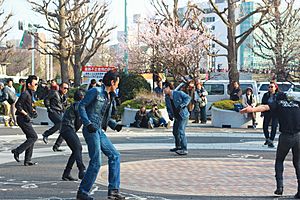
In the 1990s and 2000s, many big international fashion brands like Gap and H&M opened their main stores here. At the same time, new, unique fashion shops popped up in the quieter backstreets of Jingumae. This area became known as Ura-Harajuku, or the "Harajuku Backstreets."
In 2006, the modern Omotesando Hills shopping complex opened. In 2008, a new subway line, the Tokyo Metro Fukutoshin Line, made it even easier to get to Harajuku from other parts of Tokyo.
Explore Harajuku: Fun Things to See and Do
Harajuku is a fantastic place for shopping, eating, and just soaking in the atmosphere. It's especially famous as a meeting spot for fans of Japanese street fashion and unique subcultures. The pedestrian bridge, Jingu Bashi, near Harajuku Station used to be a popular spot on Sundays to see people showing off their amazing styles.
Here are some other cool places to visit in Harajuku:
- Meiji Shrine: A beautiful Shinto shrine surrounded by a peaceful forest. It's dedicated to Emperor Meiji and his wife.
- Yoyogi Park: A large park perfect for relaxing, picnics, and watching people.
- Yoyogi National Gymnasium: A cool building designed by Kenzo Tange. It hosted events for the 1964 Tokyo Olympics.
- Omotesando: A wide, tree-lined avenue with many fancy shops and cafés.
- Ura-Harajuku: The "backstreets" full of unique, independent fashion stores.
- Laforet Harajuku: A popular fashion mall with many trendy shops.
- Omotesando Hills: A modern shopping complex on Omotesando.
- Tōgō Shrine: A shrine dedicated to a famous Japanese admiral.
- Ukiyo-e Ōta Memorial Museum of Art: A museum where you can see traditional Japanese woodblock prints.
- Nezu Museum: A museum with a beautiful Japanese garden and Asian art.
Getting Around Harajuku
Train Stations
- Harajuku Station (JR East Yamanote Line)
- Meiji-jingumae 'Harajuku' Station (Tokyo Metro Chiyoda Line, Tokyo Metro Fukutoshin Line)
Main Roads
- Meiji Street
- Omotesando Street
- Gaien-nishi Street
Images for kids


